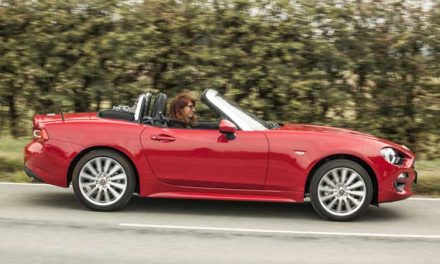They’re all sold. If you sometimes get angry over tests of cars with sheikhs and cigar-chomping industrialists for clients, all I can say to get me out of your doghouse this time is that they’re all sold anyway. The whole limited run of 375 McLaren P1 hypercars, gone, with last deliveries a while ago in July 2015. So put down the torches and pitchforks, and read along while McLaren sets me loose for some fast times in their P1 hybrid plug-in exotica.
Not too loose, though. This test is all on track at the Dunsfold airfield circuit south of London UK, the circuit set up frequently for filmings of Top Gear episodes. I’ve been here before and it was always raining. Hooray, not today.

The Drive
Dry tarmac is needed for what I’m about to do, or for what’s about to be done to me. The €1-million 2015 McLaren P1 is sort of the dark and mysterious one of the three new hypercars of the green apocalypse. The other two are the more marquee-hogging €790.000 Porsche 918 Spyder and the $1,1-million Ferrari LaFerrari. The P1’s so-called IPAS hybrid powertrain (i.e. Instant Power Assist System which is McLaren-talk for KERS or the Kinetic Energy Recovery System used on Formula One cars), can boom out 916 horsepower. It slings you from 0 to 100 kilometres per hour in just 2,8 seconds. Probably faster than that actually.
The design of the McLaren P1 reminds me of a very aerodynamic fancy pro cycling helmet. The design and engineering teams say it was formed by the wind. (Okay…) See, the trick for any over-performing car is to let it go as fast as you would dream it to go while quite frankly just making sure that it does not lift off the ground at highest speeds, sending clients into orbit. The P1 can reach 350 km/h, so keeping it on the ground is fundamental here. Acceleration to 300 km/h can happen in just 16,5 seconds, way more than quick enough to launch a private plane at the airstrip.
It is so tempting to dive deep into the tech dreck here, but I shall mostly refrain because the best part really about the P1 is how it sets your neck hairs on fire while taking a hot corner at speeds before now thought stupid. The specially formulated Pirelli P Zero Corsa tyres – 19 inches in front and 20 inches in back – work overtime with the P1’s intricate adaptive suspension to keep the action grippy and comfy enough at all times. It is in this portion of how the P1 compares to the Porsche 918 Spyder I tested where the P1 wins. Not just in pure straight acceleration, where the P1 dusts the 918 once speeds reach beyond 100 km/h, but it’s in the fast curves and weight shifts where the P1 absolutely glows.


The Technology
If a supercar’s lateral acceleration number – i.e. the amount of sideways g-force that builds up until the car’s tires no longer hold the pavement as speed builds in a constant curve – reaches 1,2 gs, that’s considered pretty great. The McLaren P1 and its €5.000 set of specially designed Pirellis can bear up to peaks of 2,4 gs on good, dry asphalt before trouble is your middle name. It can hold 2,0 gs in a steady state until the lithium-ion battery array and fuel tank are both dry. This has never before been possible for me in any car ever made.
Stunning side-to-side stability is thus assured. What about front-rear dynamics then? The P1 can move quickly from a stop sign and then on up to its 350-km/h v-max without a sweat, but I need to know it’ll hunker down hard and also slow up just as quickly. The special hydraulic adaptive shock absorbers, the Formula One-caliber ceramic brake pads, the much lower transformational Race mode of the RaceActive Chassis Control, and the sexy gi-normous air-brake standing tall outback when fully extended, are here to report for duty. Time to try it all.
Getting into the high-sided competition Recaro seats bathed in clinging Alcantara is actually not so hard to learn. Hoist the lightweight skyward door of carbon composite, thrust your right leg in deep to the footwell, bend at the waist, and – plop – you’re in. Press the Start button at top dead centre of the middle dash and the McLaren 3,8-litre bi-turbo V8 engine snarls hard to live, even snarlier if you start it after arriving in Race mode. I was in my P1 with Mclaren 12C GT3 race driver Duncan Tappy in the passenger seat to help translate all the functions and laugh at me whenever I screwed something up. I have been lucky enough to drive the McLaren MP4-12C quite a bit over these last couple of years and the layout of the P1 cabin is pretty similar. I was able to pick up speed in this new €1-million environment pretty quickly.
And, uhmm, the P1 is so freaking quick. It’s also a car that’s like a playful pitbull on a sugar high once you settle in and are jabbing into curves and wiggling out the tail without fear. Master Tappy to my right walked me through lap after lap, ramping up the drama from Normal to Sport to Track over six laps. The differences were tangible from the mood to mood, but nothing really glaring and especially gut-wrenching compared to the other whizzbang exotics out there. Just pretty much as one would expect from a 916-ps car built by a Formula One company and weighing only 1.395 kgs.
Well, I take that back a little, the steering is insanely smooth and quick, just 2,2 turns lock-to-lock versus the 12C on the same aluminium-carbon architecture with 2,6 turns. I also noticed the positive dynamic effects of scooching the two passenger seats closer together in the middle of the car. How the P1 moves during quick direction changes and controlled oversteer out of curves is made all the better by this reorientation of the human flesh right over the centre point of the car. And the brakes brought in from the Japanese supplier that makes whole braking systems for the Formula One circus are unbelievable in reeling in this momentum monster.


Then Came The Race
Oh, man, oh, man. Park the P1 and turn off the engine. Foot on brake, turn on the ignition so the dash lights up, and keep your button-pressing finger on the Race button at low-centre of the middle dash. And wait patiently. Wait thirty seconds, in fact, for the hydraulic dampers to take your ground clearance from 120 millimetres down to 70 mms as on McLaren’s GT3 racing machines. Exactly what is happening outside the car is shown to you on the instrument cluster as the P1 lowers dramatically and that massive buffet table of an air-brake outback rises up to its highest point and angles down a little to capture more air and (Remember?) keep you from going into orbit at 300 km/h. The downward forces created in the Race setup are the highest ever recorded for a series road car. Top speed is brought down from 350 km/h to 330 km/h simply because that’s the effect all of this has naturally.
As with all such extreme states, you only feel everything that is possible here in Race-land once you break through your personal barriers and let it all hang out. Which I did to my best abilities with someone else’s slightly priceless prototype. But I also nonetheless told Duncan to give me a couple properly boiling laps after I got finished thoroughly underwhelming him with my awesome skills.
The McLaren P1 – at this dimension of car – is the best thing going. If Porsche comes out with a hot little Cayman GTS model for real, then only that can come this close to balance and dynamic perfection, Although the Ferrari 458 Italia, Spider and Speciale are all pretty close to this already in their league as well. The aiming and shooting for everything on the Dunsfold circuit in the McLaren P1 got me the closest yet to Stigdome in this life. The V8 with larger turbochargers fitted and the 176-bhp electric motor are bodacious dance partners when working together in full boost, pedal to the floor.
Mister Tappy shouted at me over the bellowing big exhaust note, “Press the red IPAS button at the next straight when you floor it!” I did so and the effect is sensational. It is such a cool trick to feel all of the e-motor urging to come into play as I enter the longest straight. My arms stretch out as my body is pushed into the seat and it is thoroughly addictive. On the next pass at the same straight, I press both the IPAS button at the right and the DRS blue button with my left thumb. This combo gives me the thrust and the less downforce in back so that the straight is over in an instant and I have overtaken the entire field of F1 drivers trying to keep me from my podium finish. I really wished that I could have done this in the 918 Spyder.


The Final Lap
My final lap was in full E-mode where only the e-motor is making forward progress possible. This mode from full e-load, without recharging or recuperating much energy through coasting or braking, can last up to 12 kms. Today it lasted about one lap and then the V8 ignited to keep the show rolling. This was where it became clearer than before that the only really ambitious hybrid hypercar that can be called green much is the 918 Spyder from Porsche. You can get to about 8,4 litres per 100km average with the McLaren, so it’s not too shabby, and pressing the Charge button can fully reload the batteries in just ten minutes, but the electrics here are almost exclusively for a boost as on this next season’s Formula One car. That and downtown urban driving, which is nice to be able to do for the breathing pedestrians.
Oh, then the hot laps by Duncan wrapped up my brief sojourn in the field of burning neck hairs. I mean, the guy races McLarens for a living and did much of the track testing mileage in the P1 prototypes. Take what I did in Race (and which I thought was SO awesome) and double it. The dynamics – I keep repeating that, sorry – but the dynamics are simply from a parallel universe. Yes, this driver is a hardcore pro, but this car, the P1, is meeting him excellent move for excellent move, and the effect is downright geometrical when they come together. I so want one of these cars with my riches earned as an auto journalist.
But, aw shoot, they’re all sold.
















